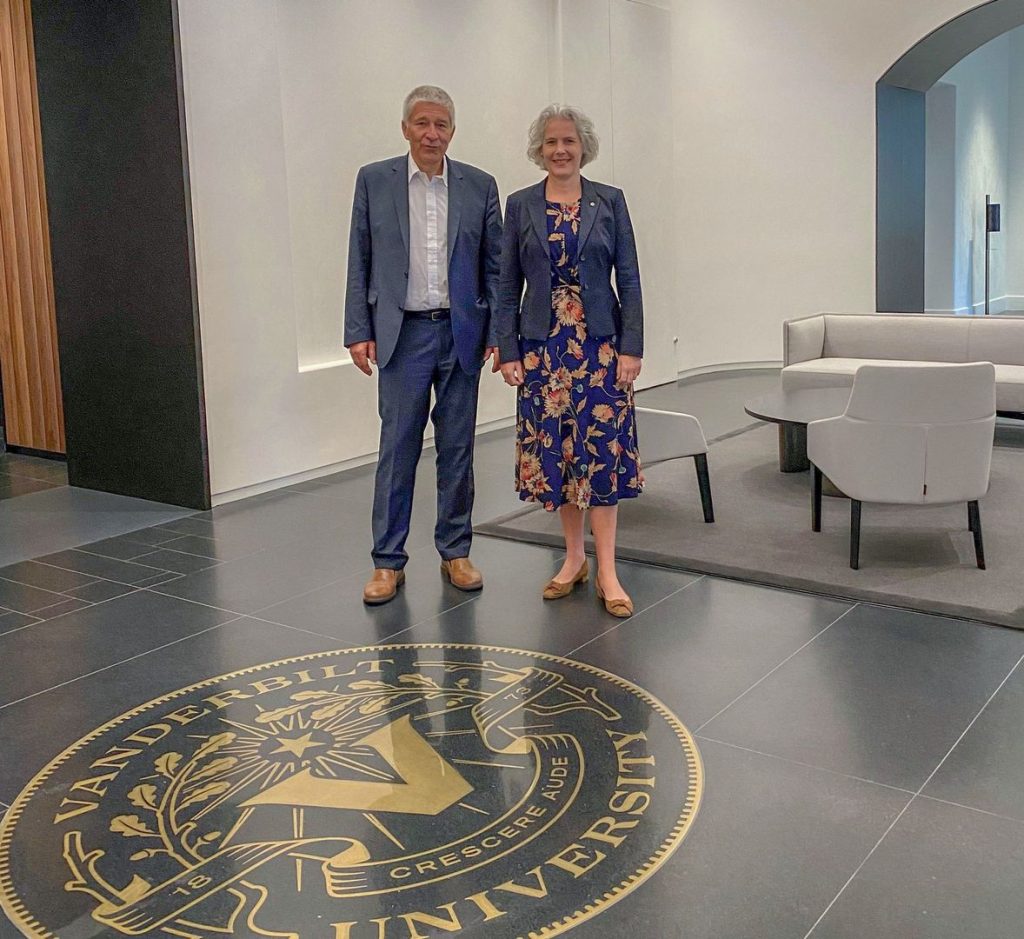Vanderbilt and Leipzig Universities extend collaboration until 2030
The partner universities Leipzig and Vanderbilt in Nashville, Tennessee (US) intend to continue their close cooperation until 2030. During a visit to Nashville by a delegation from Leipzig University led by Rector Professor Eva Inés Obergfell and Vice-Rector for Campus Development: Cooperation and Internationalisation, Professor Matthias Middell, the two sides signed a joint collaboration agreement on Tuesday evening (20 August, local time), extending their 15-year relationship for a further six years. The aim is to further develop cooperation in research, teaching, and knowledge and technology transfer and to focus on the joint promotion of early career researchers.
At a ceremony in the Vanderbilt Tower in Nashville, the ten-member delegation from Leipzig was welcomed by the Chancellor of Vanderbilt University, Professor Daniel Diermeier, and the Vice Provost for Global Engagement, Professor Tracy Denean Sharpley-Whiting. This marked the start of the collaboration celebrations in Nashville. “Vanderbilt University is one of our closest and most important partners in the United States. So I am extremely pleased that we will be continuing our tried-and-tested partnership in the coming years and even deepening our relationship. Especially in these politically turbulent times, we need scientifically sound discourse and friendly dialogue, and I am glad that our American partners in Nashville see it the same way,” says Rector Obergfell.

The programme includes a scientific workshop from 20 to 23 August. Once again, medical and scientific researchers will present their latest findings in symposia designed to deepen existing research collaborations and initiate new ones. The 15th anniversary of the universities’ partnership and ten years of support from the Max Kade Foundation were celebrated with an accompanying cultural programme.
The workshop was also the kick-off meeting for the collaboration between the Center for Scalable Data Analytics and Artificial Intelligence (ScaDS.AI) at Leipzig University and TU Dresden with the Lab for Immersive AI Translation (VALIANT) and the Center for Applied AI in Protein Dynamics at Vanderbilt University. Over the next few years, it is planned to strengthen scientific cooperation in the field of computer science, with a focus on artificial intelligence and its application in a wide range of disciplines, from the humanities (digital humanities), life sciences, earth sciences (biodiversity) and social sciences to medicine and natural sciences.
“The establishment of a strategic partnership with Vanderbilt University is one of the cornerstones of our internationalisation strategy. This means achieving the widest possible range of participating disciplines, which was reflected in the composition of the Leipzig delegation: scholars from medicine, science, cultural studies and law travelled to Nashville to build new networks. And we have identified formats where we want to develop further together,” says Vice-Rector Middell.

Originating in biochemistry, the collaboration is now active and successful in many disciplines. In addition to a steadily growing academic exchange and many joint, externally funded projects, the partner university is a sought-after and attractive destination for international research stays, especially for doctoral researchers from Leipzig.
“This university partnership has produced unique interdisciplinary work and played a key role in shaping people’s careers. The programme has also evolved over time, with new research questions, new projects and new project partners, but the intensive research collaboration has not changed. Supporting excellent scientists not only enriches the universities, but also has an international impact on the research sector. We want to continue to support and motivate young female scientists to conduct research in the US and Germany,” says Annette Beck-Sickinger, who coordinates the university partnership at Leipzig.
“This support secures the framework conditions for research stays and provides a basis for subsequent projects, contributes to the qualification of young researchers, promotes the transfer of knowledge between disciplines and enables follow-up funding for joint collaborative projects. I am particularly pleased that the delegation from Leipzig University includes several young professors who are looking for new collaborations that will take this cooperation in new directions,” says Jens Meiler, coordinator of the university partnership at Vanderbilt University and Humboldt Professor at Leipzig University.

